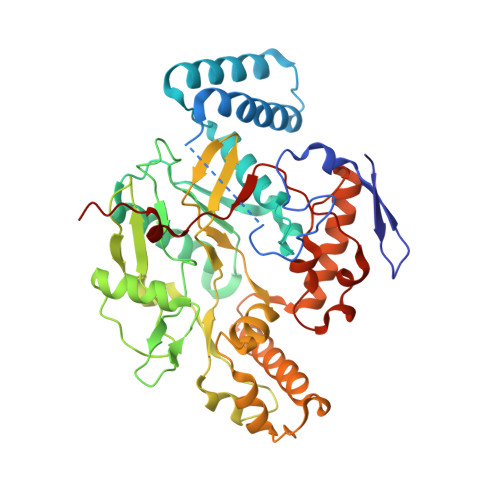Single crystal structural and absorption spectral characterizations of nitric oxide synthase complexed with N(omega)-hydroxy-L-arginine and diatomic ligands.
Doukov, T., Li, H., Soltis, M., Poulos, T.L.(2009) Biochemistry 48: 10246-10254
- PubMed: 19791770
- DOI: https://doi.org/10.1021/bi9009743
- Primary Citation of Related Structures:
3HSN, 3HSO, 3HSP - PubMed Abstract:
The X-ray structures of neuronal nitric oxide synthase (nNOS) with N(omega)-hydroxy-l-arginine (l-NHA) and CO (or NO) bound have been determined at 1.91-2.2 A resolution. Microspectrophotometric techniques confirmed reduced redox state and the status of diatomic ligand complexes during X-ray diffraction data collection. The structure of nNOS-NHA-NO, a close mimic to the dioxygen complex, provides a picture of the potential interactions between the heme-bound diatomic ligand, substrate l-NHA, and the surrounding protein and solvent structure environment. The OH group of l-NHA in the X-ray structures deviates from the plane of the guanidinium moiety substantially, indicating that the OH-bearing, protonated guanidine N(omega) nitrogen of l-NHA has substantial sp(3) hybridization character. This nitrogen geometry, different from that of the guanidinium N(omega) nitrogen of l-arginine, allows a hydrogen bond to be donated to the proximal oxygen of the heme-bound dioxygen complex, thus preventing cleavage of the O-O bond. Instead, it favors the stabilization of the ferric-hydroperoxy intermediate, Fe(3+)-OOH(-), which serves as the active oxidant in the conversion of l-NHA to NO and citrulline in the second reaction of the NOS.
Organizational Affiliation:
Macromolecular Crystallographic Group, The Stanford Synchrotron Radiation Lightsource, SLAC, Stanford University, Stanford, California 94309, USA.





















